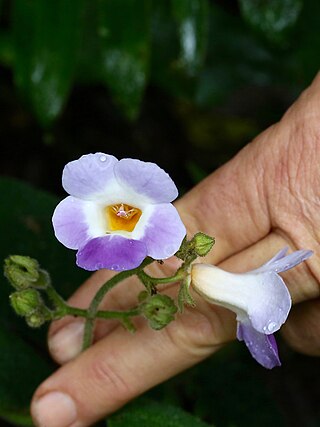
Columnea is a genus of around 200 species of epiphytic herbs and shrubs in the family Gesneriaceae, native to the tropics of the Americas and the Caribbean. The tubular or oddly shaped flowers are usually large and brightly colored – usually red, yellow, or orange – sometimes resembling a fish in shape. A common name is flying goldfish plants due to the unusual flower shape.

Kohleria is a New World genus of the flowering plant family Gesneriaceae. The plants are generally tropical herbs or subshrubs with velvety stems and foliage and brightly colored flowers with spots or markings in contrasting colors. They are rhizomatous and commonly include a period of dormancy in their growth cycle. The genus was revised in 1992 and was then recognized as having 19 species distributed in Central America and South America. phylogenetic in 2005 indicated that the epiphytic genus Capanea is derived from within Kohleria, and the two species of Capanea were subsequently transferred to Kohleria. The genus Pearcea is closely related.

Pearcea is a genus of tropical herbaceous plants in the family Gesneriaceae native to western South America. It is classified in tribe Gloxinieae and is closely related to the genus Kohleria, in which some of its species were previously included. The genus Parakohleria has recently been synonymized under Pearcea, a conclusion later supported by molecular analyses that showed that Pearcea hypocyrtiflora was nested within the former Parakohlerias.

Alsobia is a genus of flowering plants in the family Gesneriaceae, native to Mexico, Guatemala, and Costa Rica. It contains four species.

Besleria is a genus of large herbs and soft-stemmed subshrubs or shrubs in the flowering plant family Gesneriaceae. It includes 176 species native to tropical southern Mexico, Central America, South America, and the West Indies.

Gasteranthus is a genus of 35 species of herbs and soft-stemmed subshrubs in the flowering plant family Gesneriaceae. The species occur in Central America and South America, from southernmost Mexico to Bolivia. Numerous species are threatened with extinction, mainly due to deforestation. This is due to two reasons: For one thing, Gasteranthus species are native to countries in which destruction of primary forest runs rampant; also, these plants do not distribute well and therefore endemism is very frequent, for example on isolated mountain ranges.

Alloplectus is a genus of Neotropical plants in the family Gesneriaceae. A 2005 revision of the genus included five species, with the majority of species in the genus as traditionally circumscribed being transferred to Crantzia, Glossoloma, and Drymonia. Plants of the World Online currently accepts seven species.

Monopyle is a genus of plants in the family Gesneriaceae.
Napeanthus is a genus of plant in family Gesneriaceae. It includes 17 species of terrestrial, perennial herbs with rhizomes native to the tropical Americas, ranging from Mexico to Bolivia and southern Brazil.

Nautilocalyx is a genus of plants in the family Gesneriaceae. Its native range stretches from Costa Rica to southern Tropical America and to Trinidad. It is also found in Bolivia, Brazil, Colombia, Costa Rica, Ecuador, French Guiana, Guyana, Panamá, Peru, Suriname, Trinidad-Tobago and Venezuela.

Paradrymonia is a genus of flowering plants in family Gesneriaceae. It includes 11 species native to the tropical Americas, ranging from Honduras to Bolivia and northern Brazil.

Reldia is a genus of plants in the family Gesneriaceae. They are also in the Beslerieae tribe.

Trichodrymonia is a genus of flowering plants belonging to the family Gesneriaceae.
Amalophyllon is a genus of flowering plants belonging to the family Gesneriaceae. It includes 13 species native to the tropical Americas, ranging from southern Mexico through Central America to Venezuela and Peru.
Anetanthus is a genus of flowering plants belonging to the family Gesneriaceae.
Centrosolenia is a genus of flowering plants belonging to the family Gesneriaceae.

Cremosperma is a genus of flowering plants belonging to the family Gesneriaceae.
Cremospermopsis is a genus of flowering plants belonging to the family Gesneriaceae.
Pheidonocarpa is a genus of flowering plants belonging to the family Gesneriaceae. It includes a single species, Pheidonocarpa corymbosa, a lithophytic subshrub native to Cuba and Jamaica.
Codonanthopsis anisophylla is a species of flowering plant in the family Gesneriaceae. This species is native in Guyana and mainly grows in wet tropical biomes. The species was first described in the genus Paradrymonia from a specimen collected in 1960, and transferred to Codonanthopsis in 2013.












